
Tourism Places In rajsamandHighlights of rajsamand In rajsamand the Kumbhalgarh Fort nestling in the Aravalli ranges is the birth place of Maharana Pratap Built by Rana Kumbha in early 15th century it is an impregnable fortress and also Haldighati is the famous battle in rajsamand. KumbhalGarh 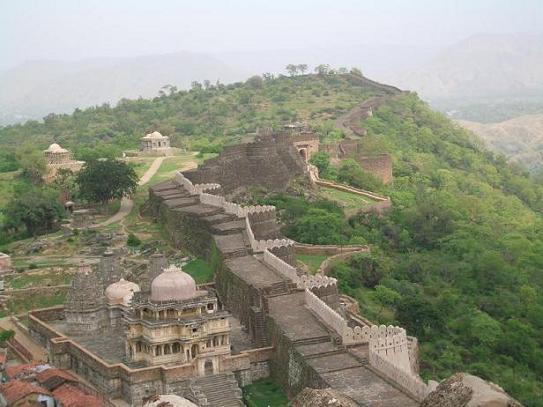 KumbhalGarh is 64 k.m. north west of Udaipur and birthplace of Maharana Pratap, Kumbhalgarh is the second most important citadel of Mewar after Chittorgarh. The Aravali ranges protect this impregnable fortress. Thirteen mountain peaks surround it. It is built on the top most ridges, 914 meters above sea level. Seven huge and imposing gates stand like sentinels at the approaches and seven ramparts, one being folded within another with crenellated walls strengthened by rounded bastions and immense watch towers, make this an impregnable mountain fortress. It was built by Rana Kumbha (1419-63). It's serpentine 36 kilometres long wall is thick and broad enough for eight horses to ride abreast. This wall is second only to the 'Great Wall of China'. There are 360 temples within the fortress, out of which a Shiva temple placed with huge 'SHIVALINGA' makes it worth visiting.
KumbhalGarh is 64 k.m. north west of Udaipur and birthplace of Maharana Pratap, Kumbhalgarh is the second most important citadel of Mewar after Chittorgarh. The Aravali ranges protect this impregnable fortress. Thirteen mountain peaks surround it. It is built on the top most ridges, 914 meters above sea level. Seven huge and imposing gates stand like sentinels at the approaches and seven ramparts, one being folded within another with crenellated walls strengthened by rounded bastions and immense watch towers, make this an impregnable mountain fortress. It was built by Rana Kumbha (1419-63). It's serpentine 36 kilometres long wall is thick and broad enough for eight horses to ride abreast. This wall is second only to the 'Great Wall of China'. There are 360 temples within the fortress, out of which a Shiva temple placed with huge 'SHIVALINGA' makes it worth visiting. Dewair At the Northern edge of Mewar, Dewair is situated between the mountain ranges spread in close proximity of Kumbhalgarh and Madaria. In the olden times it had been under the domination of different tribes from Mer to Deora Rajputs. Maharana Pratap made the adventurous military campaigns of the Mughal ruler ineffective by resorting to gorilla warfare. On the auspicious occasion of Vijaya Dashmi, in 1852, he was crowned with historic victory, which led to the automatic liquidation of all 36 Moghul military outposts in Mewar. After this humiliating defeat Akbar stopped his military campaigns against Mewar. The victory of Dewair was a crowning glory for Maharana Pratap. Col. James Tod described Dewair as "Marathon of Mewar" . In his famous book "Anals and Antiquities of Rajputana" . A victory Memorial for Pratap is proposed to be erected here. rajsamand Lake 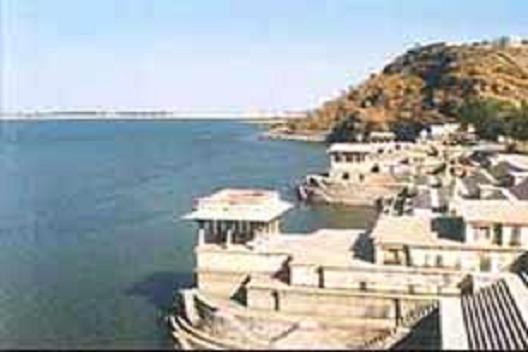 This royal lake is located 66km from Udaipur. rajsamand or the royal lake is one of the numerous artificial lakes found in the Mewar region and was built by Rana Raj Singh I in the 1660s. The lake is a large one, 4 miles long and 1.75 miles wide. It has a huge embankment (bund) that is over 1100ft long and 40ft high with several decorative arches and pavilions built by Raj Singh. The Gomti River flows into it, ensuring that it never remains dry. The Nauchowki (nine pavilions) stands mute next to the calm and serene rajsamand. The white marble steps down to the lake date back to the 17th century when Maharani Roopmati had them made to show her gratitude to her husband Maharana Raj Singh I. Raj Singh had saved her from the hands of the Mughal Emperor Aurangzeb (see Rana Raj Singh I in History for more details.) 27 stone slabs carved in the 17th century bear the longest Sanskrit inscription known in India. The slabs, known as Raj Prahasti, mention the history of the State of Mewar in a verse of 1017 stanzas.
Maharana Raj Singh an able administrator of the fifth generation of Maharana Pratap constructed rajsamand lake in 1662 AD, which is a beautiful example of sculpture and public utility works. The banks known as "Nouchoki" consist of 25 carved stone 'RAJ PRASHASHTI' the longest stone inscription in Sanskrit in the world.
The stairs, footrest, artistic gates and "Mandaps" are made of beautiful carved marble and the sculpture imparts a new look every time The whole construction is based on the number 9 which is considered to be the absolute number in Hindu philosophy & mythology.
It took 14 years for completion and cost more than 12.5 million rupees at that time.
This royal lake is located 66km from Udaipur. rajsamand or the royal lake is one of the numerous artificial lakes found in the Mewar region and was built by Rana Raj Singh I in the 1660s. The lake is a large one, 4 miles long and 1.75 miles wide. It has a huge embankment (bund) that is over 1100ft long and 40ft high with several decorative arches and pavilions built by Raj Singh. The Gomti River flows into it, ensuring that it never remains dry. The Nauchowki (nine pavilions) stands mute next to the calm and serene rajsamand. The white marble steps down to the lake date back to the 17th century when Maharani Roopmati had them made to show her gratitude to her husband Maharana Raj Singh I. Raj Singh had saved her from the hands of the Mughal Emperor Aurangzeb (see Rana Raj Singh I in History for more details.) 27 stone slabs carved in the 17th century bear the longest Sanskrit inscription known in India. The slabs, known as Raj Prahasti, mention the history of the State of Mewar in a verse of 1017 stanzas.
Maharana Raj Singh an able administrator of the fifth generation of Maharana Pratap constructed rajsamand lake in 1662 AD, which is a beautiful example of sculpture and public utility works. The banks known as "Nouchoki" consist of 25 carved stone 'RAJ PRASHASHTI' the longest stone inscription in Sanskrit in the world.
The stairs, footrest, artistic gates and "Mandaps" are made of beautiful carved marble and the sculpture imparts a new look every time The whole construction is based on the number 9 which is considered to be the absolute number in Hindu philosophy & mythology.
It took 14 years for completion and cost more than 12.5 million rupees at that time.
Kankroli An important pilgrim site for the Vaishnavas the town of Kankroli has the temples of Dwarakadhish, one of the seven forms of Lord Krishna. Maharana Raj Singh I built the temple in 1676. The idol in the temple was brought from Mathura and installed here in the year 1676. The head priest of the temple is one of the descendants of Vallabhacharya the Vaishnava Spiritual Guru. The temple has been built on a hill and overlooks the beautiful rajsamand Lake. It makes a pretty sight, quite grand and attractive from across the lake. Several dharamshalas (inexpensive guesthouses found mainly at pilgrim sites) adjoin the temple and are also found at the base of the hills. Eklingji 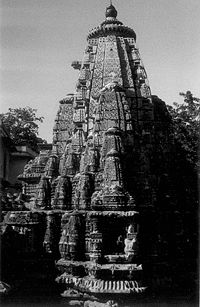 Eklingji is a Hindu temple complex in Udaipur District of Rajasthan in western India. It is located 22 km north of Udaipur. Eklingji is believed to be the Ruling deity of Mewar Princely State and the Ruler Maharana rules as his Dewan.
Begun in 971, the temple complex was built by the Guhila (later called Sesodia) dynasty of Mewar, in honor of their presiding deity Eklingji, a form of Lord Shiva. The beautifully sculpted temple complex includes 108 temples within its high walls. The main temple dates to the 15th century, rebuilt from the ruins of an earlier destroyed temple. It is made of marble and granite and has an enormous double-storied, elaborately pillared hall or "mandap" under a vast pyramidal roof, with a four-faced image of Lord Shiva in black marble. Another temple in the complex is the Lakulish Temple; built in 971, it is the only temple of the Lakulish sect in the whole of India.
Eklingji is a temple complexes situated nearly 22 km in the north of Udaipur. It is convenient to reach the temple location by bus and car. The Eklingji temple is escorted by the long walls of hard rock. This fascinating temple was built in 734 A.D, which consist of 108 temples chiseled out of sandstone and marbles. The temple complex is devoted to the royal family of Mewar. Beside this there are many ancient temples like Shiva Temple, this temple was build in the time of Maharana Raimal between 1473 and 1509.The walled complex of Eklingji has an elaborately pillared hall under a large pyramidal roof and depicts the four-faced Shiva image of black marble. Most of the faithful pilgrims visit temple on Monday to seek the special blessings of god. Whereas other days of the week the temple is relatively crowd free. The Maharana of Udaipur pays a private visit to the temple on Monday evening. Nearly 1 km before Eklingji, the Nagda town is located. This place is famous for its Sas-bahu and Adbudji temple. The Sas-Bahu Temple is widely known for its exquisite carvings on the stones. The temple carvings are related to the incidents of great Indian epic Ramayana. Eklingji is a great devotional place for Hindu tourist in India. The tourist can access to this place from RSTC buses that runs from Udaipur to Eklingji and other major destinations of Rajasthan, that hardly takes an 1 hour to reach Eklingji from Udaipur.
Eklingji is a Hindu temple complex in Udaipur District of Rajasthan in western India. It is located 22 km north of Udaipur. Eklingji is believed to be the Ruling deity of Mewar Princely State and the Ruler Maharana rules as his Dewan.
Begun in 971, the temple complex was built by the Guhila (later called Sesodia) dynasty of Mewar, in honor of their presiding deity Eklingji, a form of Lord Shiva. The beautifully sculpted temple complex includes 108 temples within its high walls. The main temple dates to the 15th century, rebuilt from the ruins of an earlier destroyed temple. It is made of marble and granite and has an enormous double-storied, elaborately pillared hall or "mandap" under a vast pyramidal roof, with a four-faced image of Lord Shiva in black marble. Another temple in the complex is the Lakulish Temple; built in 971, it is the only temple of the Lakulish sect in the whole of India.
Eklingji is a temple complexes situated nearly 22 km in the north of Udaipur. It is convenient to reach the temple location by bus and car. The Eklingji temple is escorted by the long walls of hard rock. This fascinating temple was built in 734 A.D, which consist of 108 temples chiseled out of sandstone and marbles. The temple complex is devoted to the royal family of Mewar. Beside this there are many ancient temples like Shiva Temple, this temple was build in the time of Maharana Raimal between 1473 and 1509.The walled complex of Eklingji has an elaborately pillared hall under a large pyramidal roof and depicts the four-faced Shiva image of black marble. Most of the faithful pilgrims visit temple on Monday to seek the special blessings of god. Whereas other days of the week the temple is relatively crowd free. The Maharana of Udaipur pays a private visit to the temple on Monday evening. Nearly 1 km before Eklingji, the Nagda town is located. This place is famous for its Sas-bahu and Adbudji temple. The Sas-Bahu Temple is widely known for its exquisite carvings on the stones. The temple carvings are related to the incidents of great Indian epic Ramayana. Eklingji is a great devotional place for Hindu tourist in India. The tourist can access to this place from RSTC buses that runs from Udaipur to Eklingji and other major destinations of Rajasthan, that hardly takes an 1 hour to reach Eklingji from Udaipur. Chetak Tomb 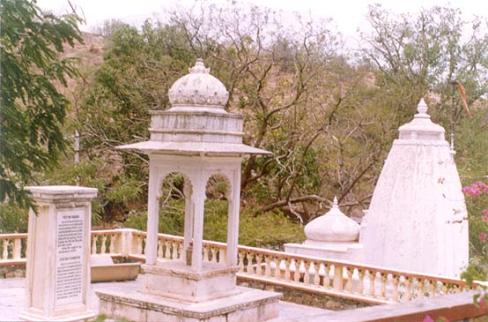 Chetak Tomb is Only 2 km. West of Haldi Ghati lies the tomb of Chetak. After being seriously wounded and loosing a leg in the fierce battle of Haldi Ghati, Chetak dutifully carried his master, Maharana Pratap, safely to this place and at last after crossing a stream, fell dead. Here stands a monument constructed and dedicated to the memory of this royal steed.
Adjacent to the tomb, there is a temple of Lord Shiva. It appears that the Great Animal "Chetak" lies here in eternal sleep at the feet of his lord 'Pashupatinath'.
Chetak Tomb is Only 2 km. West of Haldi Ghati lies the tomb of Chetak. After being seriously wounded and loosing a leg in the fierce battle of Haldi Ghati, Chetak dutifully carried his master, Maharana Pratap, safely to this place and at last after crossing a stream, fell dead. Here stands a monument constructed and dedicated to the memory of this royal steed.
Adjacent to the tomb, there is a temple of Lord Shiva. It appears that the Great Animal "Chetak" lies here in eternal sleep at the feet of his lord 'Pashupatinath'. Haldighati Haldighati is a mountain pass in the Aravalli Range of Rajasthan in western India. It connects rajsamand and Pali districts, 40 kilometres from Udaipur. The name is believed to have come from the turmeric-coloured yellow soil (Turmeric is haldi in Hindi). The mountain pass is historically significant as the location of the historic Battle of Haldighati, which took place in 1576 between Rana Pratap Singh of Mewar and Raja Man Singh of Amber, general of the Mughal emperor Akbar. Kumbhalgarh 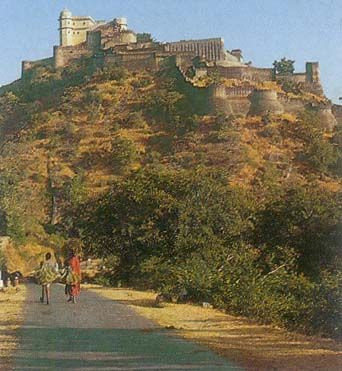 Kumbhalgarh also called Kumbhalmer or Kumbalgarh is a Mewar fortress in the rajsamand District of Rajasthan state in western India. Built during the course of the 15th century CE by Rana Kumbha , and enlarged through the 1800s, Kumbhalgarh is also a birthplace of Maharana Pratap, the great king and warrior of Mewar. Occupied till the nineteenth century, the fort is now open to the general public as a museum and is spectacularly lit for a few minutes each evening. Kumbalgarh is situated 82 km from Udaipur towards its northwest and is easily accessible by road. It is the most important fort in Mewar after Chittaurgarh.
Kumbhalgarh also called Kumbhalmer or Kumbalgarh is a Mewar fortress in the rajsamand District of Rajasthan state in western India. Built during the course of the 15th century CE by Rana Kumbha , and enlarged through the 1800s, Kumbhalgarh is also a birthplace of Maharana Pratap, the great king and warrior of Mewar. Occupied till the nineteenth century, the fort is now open to the general public as a museum and is spectacularly lit for a few minutes each evening. Kumbalgarh is situated 82 km from Udaipur towards its northwest and is easily accessible by road. It is the most important fort in Mewar after Chittaurgarh.Built on a hilltop 1900 metres in altitude, Kumbhalgarh fort has perimeter walls that extend 36 kilometres in length, claimed to be the longest in the world after the Great Wall of China. The frontal walls are fifteen feet thick. Kumbhalgarh has seven fortified gateways. Over 360 temples are within the fort, 300 ancient Jain and the rest Hindu. The vista from the palace top typically extends tens of kilometers into the Aravalli Range. It is widely believed that the sand dunes of the Thar desert can be seen from the fort walls. According to legend the Maharana of Kumbhalgarh tried so many times to build the wall of the fort but each time failed to do so. They consulted a local pilgrim about their construction problems. The pilgrim advised that he be beheaded and after cutting his head to build a temple where the head should fall, and to build the wall and the fort where the rest of his body lay. Following his advice, they succeed in building the world's second largest wall. According to popular folklore, Maharana Kumbha used to burn massive lamps that consumed fifty kgs of Ghee and a hundred kgs of cotton to provide light for the farmers who worked during the nights in the valley. The site where Kumbhalgarh stands today was once a bastion, was once ruled by Prince Samprati and his dynasty who were Jain descendents of Mauryan emperors of India during the second century CE. Kumbhalgarh in its present form was developed by, and said to be personally designed by Rana Kumbha. Rana Kumbha's kingdom of Mewar stretched from Ranthambore to Gwalior and included large tracts of erstwhile Madhya Pradesh as well as Rajasthan. Out of the 84 forts in his dominion, Rana Kumbha is said to have designed 32 of them, of which Kumbhalgarh is the largest and most elaborate. Kumbhalgarh also separated Mewar and Marwar from each other and was used as a place of refuge for the rulers of Mewar at times of danger. A notable instance was in the case of Prince Udai, the infant king of Mewar who was smuggled here in 1535, when Chittaur was under siege. Prince Udai who later succeeded to the throne was also the founder of the Udaipur City. Kumbhalgarh was captured by the combined armies of Emperor Akbar, along with the armies of Raja Man Singh of Amber and Raja Udai Singh of Marwar . The fort's capitulation was accelerated by the scarcity of drinking water. Rakam Garh About 10 kilometres South-East of rajsamand is the famous fort of Rakamgarh, a small fortress built upon a small hillock, is said to be the silent evidence of the fight for freedom fought between Tantya Tope and the British troops in 1857, in the fields of Rakamgarh. It is also said that Tantya Tope stayed here in the Rakamgarh Fort for a short duration and was given all type of the help by the than ruler of Kotharia and the Tilkayat of Shrinathji. Nathdwara 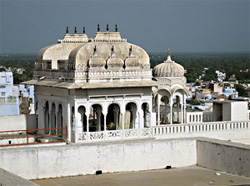 Nathdwara is a city in Rajasthan state of western India. It is located in the Aravalli hills, on the banks of the Banas River in rajsamand District, just north of Udaipur. This holy town is famous for its temple of Krishna which houses the Shrinathji, a 12th century "infant" incarnation idol (murti) of Krishna. The idol was moved in the 17th century from Govardhan hill, near Mathura along holy river Yamuna, to protect it from the Mughal emperor Aurangzeb's campaign against Hindu worship in his empire. The Haveli of Shrinathji (as the temple is called), was once a royal palace of the Sesodia Rajput rulers of Mewar.
Shri Nathdwara (a pathway to Lord Shri Krishna) lies 48 km from Udaipur and literally means the gateway to the Lord Shri Nathji. This great Vaishnavite shrine was built in the 17th century on spot exactly identified by the Lord himself. The legends have that the idol of the Lord Krishna was being transferred to safer place from Vrindaban to protect it from the destructive wrath of the Mughal Emperor Aurangzeb. When the idol reached this spot, the wheels of bullock cart it was traveling in, sank axel deep in mud and refused to move further, at all. The accompanying priest realised that this was Lord's chosen spot and the Lord did not want to travel any further. Accordingly a Temple was built here. This is a temple and place of pilgrimage amongst its believers.
Devotees throng the shrine in large numbers during occasions of "Janmashtami" the day of Lord's birth and other festivals like Holi, Diwali. The priests treat it like a living deity, and they tend to the Lord with daily normal function like bathing, dressing, meals called "Prasad" and the resting times in regular intervals. This deity is believed to be infant Lord Krishna, and hence special care is taken, accordingly. The priests in all Havelis are believed to be from the kul (descendants) of Shri Vallabh Acharya, the founder of this deity's idol at Govardhan hill, near Mathura.
The main attractions are the Aartees and the Shringar, i.e. the dressing and beautifying of the idol of Lord, treating it as a person, adorning it with best appropriate dresses for the time of day / night. The intricately woven shaneels and silk clothe have original zari and embroidery work done upon them, along with tonnes of real precious jewels. The formal prayers are offered with diya, incense sticks, flowers, fruit and other offerings, with local instruments and devotional songs of the Lord Shrinathji, according to the demand of the time and occasion. The view of the idol, called jhakhi, after the "parda" (curtain) is removed is a spectacular sight, that is simply mesmerizing, leading to a melee (gully) of visitors crowding to have a glimpse (jhakhi) of divine Lord. The mystic, spirited aura of India comes alive.
Nathdwara has a small but throbbing township around the temple. Its shopping in the bye lanes is a great revelation. It is famous for its 'Pichwai Paintings', with Shri Krishna in the centre of various raas-lila (pictures depicting godly acts, instances & dances) and is recognized for profuse use of pure gold color. Also, devotees prefer to buy specially made frames of Shri Nath ji, depicting various practices of dressing and rituals of the Lord for prayers at their house, made by local artists, as photographs of the idol are strictly prohibited.
Nathdwara is a city in Rajasthan state of western India. It is located in the Aravalli hills, on the banks of the Banas River in rajsamand District, just north of Udaipur. This holy town is famous for its temple of Krishna which houses the Shrinathji, a 12th century "infant" incarnation idol (murti) of Krishna. The idol was moved in the 17th century from Govardhan hill, near Mathura along holy river Yamuna, to protect it from the Mughal emperor Aurangzeb's campaign against Hindu worship in his empire. The Haveli of Shrinathji (as the temple is called), was once a royal palace of the Sesodia Rajput rulers of Mewar.
Shri Nathdwara (a pathway to Lord Shri Krishna) lies 48 km from Udaipur and literally means the gateway to the Lord Shri Nathji. This great Vaishnavite shrine was built in the 17th century on spot exactly identified by the Lord himself. The legends have that the idol of the Lord Krishna was being transferred to safer place from Vrindaban to protect it from the destructive wrath of the Mughal Emperor Aurangzeb. When the idol reached this spot, the wheels of bullock cart it was traveling in, sank axel deep in mud and refused to move further, at all. The accompanying priest realised that this was Lord's chosen spot and the Lord did not want to travel any further. Accordingly a Temple was built here. This is a temple and place of pilgrimage amongst its believers.
Devotees throng the shrine in large numbers during occasions of "Janmashtami" the day of Lord's birth and other festivals like Holi, Diwali. The priests treat it like a living deity, and they tend to the Lord with daily normal function like bathing, dressing, meals called "Prasad" and the resting times in regular intervals. This deity is believed to be infant Lord Krishna, and hence special care is taken, accordingly. The priests in all Havelis are believed to be from the kul (descendants) of Shri Vallabh Acharya, the founder of this deity's idol at Govardhan hill, near Mathura.
The main attractions are the Aartees and the Shringar, i.e. the dressing and beautifying of the idol of Lord, treating it as a person, adorning it with best appropriate dresses for the time of day / night. The intricately woven shaneels and silk clothe have original zari and embroidery work done upon them, along with tonnes of real precious jewels. The formal prayers are offered with diya, incense sticks, flowers, fruit and other offerings, with local instruments and devotional songs of the Lord Shrinathji, according to the demand of the time and occasion. The view of the idol, called jhakhi, after the "parda" (curtain) is removed is a spectacular sight, that is simply mesmerizing, leading to a melee (gully) of visitors crowding to have a glimpse (jhakhi) of divine Lord. The mystic, spirited aura of India comes alive.
Nathdwara has a small but throbbing township around the temple. Its shopping in the bye lanes is a great revelation. It is famous for its 'Pichwai Paintings', with Shri Krishna in the centre of various raas-lila (pictures depicting godly acts, instances & dances) and is recognized for profuse use of pure gold color. Also, devotees prefer to buy specially made frames of Shri Nath ji, depicting various practices of dressing and rituals of the Lord for prayers at their house, made by local artists, as photographs of the idol are strictly prohibited.Machind Machind, situated in the Aravali range, parallel to the JARGA range of mountain is historically important. Maharana Pratap and his son Amar Singh stayed here for a short duration. The remnants of the construction of Pratap's age and a "Baori" (old well) are still visible. Guru Matsyendra Nath of Nath community prayed here in a cave, after whom the place is known as Machind. Machind is also known as the birthplace of Maharana Amar Singh. |

